Media | Articles
Your handy 1975–93 Volvo 240 buyer’s guide
Throughout his career, Volvo’s chief designer, Jan Wilgaard, insisted that functional, sensible designs are the best looking. And there was no more functional, sensible design than the 240. It was the Earth Shoe of automobiles. Nearly 30 years after it ceased production, when you think of “Volvo,” the profile of this car is probably what comes to mind.
The Volvo 240 had evolutionary changes throughout its run, but Volvo sold more than 2.6 million units to an enthusiastic, overwhelmingly satisfied, worldwide audience that apparently had no interest in seeing these cars significantly change. When the 700 Series arrived in 1983, it was supposed to replace the 240, but Volvo sold more that year than it ever had before. As a tribute to its longevity, the 240 Series managed to outlive its presumptive successor by a year.
In this buyer’s guide, we’re going to talk about cars that were intended for the American market. That means “American,” not “North American,” because even the Canadian cars were slightly different. Early Canadian 240s, for example, had carburetors, while all American 240s were fuel-injected from the get-go.
Regarding production numbers: We have production figures from Volvo, via the Volvo Owner’s Club, but they’re suspect. “Many of the production figures shown, especially for the early years, are of doubtful accuracy,” reads the caveat on the Volvo Owner’s Club page. “Some give the intended output, while others indicate the number of cars believed to have been built, and the remainder represent the true production level.”
Model Overview
1975
Launched in the fall of 1974, the 240 was the natural evolution of the successful 140 Series, a compact, unibody, executive-car platform that you could squint and easily mistake for a 240. But while the exterior styling was certainly derivative of the car it was replacing, the focus on occupant safety was not. The early mission at Volvo was direct: Build a car that occupants could count on to help them survive a head-on crash into a solid barrier at 50 miles per hour.
Marketplace
Buy and sell classics with confidence
Not everything made it to the 240, but the Volvo Experimental Safety Car (VESC) shown in Geneva in 1972 had undeniable influence. Even into the early 1980s, most other cars were designed to resist impact, not to absorb it. But the 240 was designed to collapse in a crash, absorbing energy before it could reach the passengers, rather than rattling them around inside. Not only were there self-adjusting, three-point safety belts, they were standard for all four outboard seating positions.
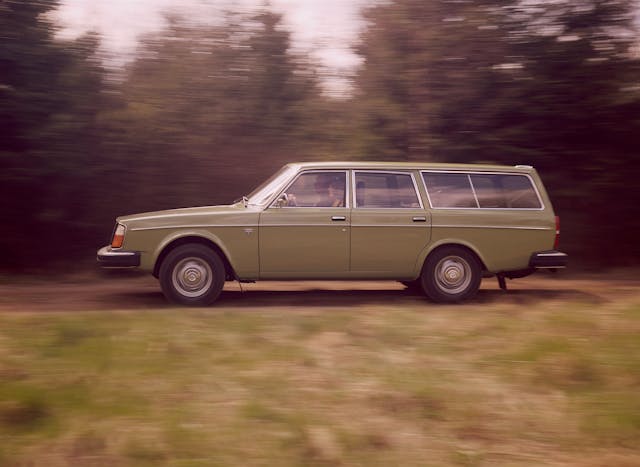
There were three body styles available: a two-door sedan (242), a four-door sedan (244), and a wagon (245), and each was available in two trims, DL and GL. The DL had cloth interior, if you got the 242 or 244, but the 245 got more rugged vinyl. Manual steering was standard on the 242 and 244 with the manual transmission. You received standard power steering in the DL if you chose the wagon. By comparison, the GL was a well-equipped car, with metallic paint, wheel trim, a manually-operated steel sunroof, a sportier steering wheel, a tachometer, power steering, and overdrive on the manual transmission.
No matter which 240 Series you purchased, you got the same engine from the 140: a pushrod 2.0-liter B20F with 8.7:1 compression and Bosch K-Jetronic fuel injection. With its U.S.-mandated catalytic converter, it put out 98 horsepower at 6000 rpm, and 110 lb-ft of torque at 3500 rpm. From a stop, you’d hit 60 miles per hour in a torpid 16.5 seconds. The quarter mile oozed past in 19.7 seconds. It’s a testament to the durability and charm that a car this painfully slow would be so universally loved almost 50 years after its introduction.
The base transmission was a Köping Engineering M40, manufactured for Volvo. The 242 and 244 GLs got the M41, the same transmission with an electrically operated overdrive, engaged via a switch on the top of the gearshift. The optional automatic was a Borg-Warner 55. The rear differential was an incredibly stout Dana 30, renamed 1030 in Volvo nomenclature. Final drive ratios were all over the map, literally, based on which country the 240 was sold and whether an automatic had been ordered. The most common ratio was 3.73.
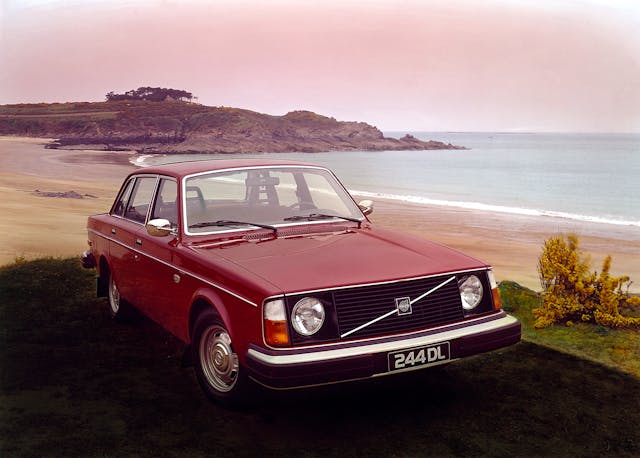
Volvo had a reputation for building the best automotive seats available, but the 240’s seats went well beyond the norm, and that fact was evident in Volvo’s marketing. In the brochure, the effusive prose about the seats went on for two pages, while the engine barely rated a page and a half, and most of that was taken up with pictures. In most cars in 1974, you got fore and aft movement. In the 240, you were afforded a reclining backrest, adjustable lumbar supports, and two inches of movement up and down for greater legroom.
“The entire Volvo interior is designed to keep you and your passengers safe, comfortable, and free from fatigue,” the brochure reads. “Safety comes first, with comfort a close second.” It highlighted an interior with legible gauges and intuitive controls that kept your eyes focused on the driving. Air conditioning was an option and used the same vents and controls as non-A/C cars.
The front suspension featured McPherson struts with coil springs and a stabilizer bar. The rear was as conventional as it got: a solid axle on coil springs with longitudinal control arms and a track rod. The sedans had the benefit of a stabilizer bar. All of the attention in the steering department went to the five ways in which the column was intended not to impale the driver, but it also actuated a rack and pinion steering system. The steering was power assisted if you bought a GL or a wagon, or if you bought a 242 or 244 with an automatic transmission. Each corner had a disc brake, operated by a dual-circuit hydraulic system that operated both front and one rear disc in case one of the channels failed, known as the “safety triangle split system.” The parking brake mechanically operated a pair of separate drum brakes.
In 1975, Volvo sold 53,804 242 two-door sedans, 82,976 244 four-door sedans, and 54,709 245 wagons, worldwide.
1976
Just a year out of the gate, Volvo was already offering American executive-sedan buyers a brand new engine. The old pushrod B20F gave way to the all-new, Redblock overhead cam B21F, a slant four-cylinder engine that set the course for Volvo for the better part of the next two decades. These engines featured electronic ignition and an aluminum crossflow cylinder head with a single camshaft driven off the front of the crank by a toothed belt. That belt turns an intermediate shaft, which then drives the distributor and oil pump. The manual transmission was upgraded to the slightly-more-durable Köping M45 four-speed and M46 four-speed with overdrive.

The options list expanded to include power front windows, a roof rack, and a reverse-facing, folding third row seat for the 245 wagon. In 1976, Volvo sold 45,144 242 two-door sedans, 90,736 244 four-door sedans, and 60,640 245 wagons.
1977
There’s little in the way of major changes for the 1977 Volvo 240, but it was Volvo’s 50th anniversary. It went all-out with a 20-page brochure heralding the event, and buyers in some markets (not the U.S., unfortunately) could purchase a Jubilee Edition 240 to mark the occasion. In 1977, Volvo sold 23,215 242 two-door sedans, 100,055 244 four-door sedans, and 48,485 245 wagons.
1978
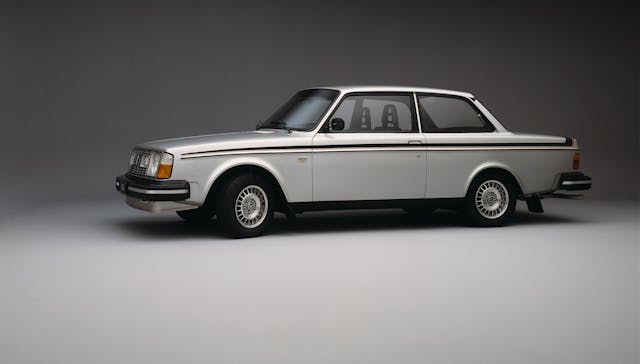
Keep an eye on the headlamps for this year. While 1976 introduced the quad round 5 1/4-inch sealed beam headlamps for U.S.-spec six-cylinder cars, the 242/244/245 cars maintained round 7-inch lamps in all trims and body styles up until 1978. In ’78, if you bought a 242, you got dual round 7-inch lamps. If you purchased a 244 or a 245, you got the 5 1/4-inch quad lamps like the six-cylinder cars.
The 242 GT arrived in 1978. It was a bigger deal outside the U.S. because it got a higher-compression engine. Also, all U.S.-spec GTs were Mystic Silver metallic with black and red stripes supplied by 3M. The interior featured black corduroy cloth upholstery with red stripes, a red stripe on the dash, a sportier steering wheel, and a tachometer mounted front and center in the instrument cluster. For the first time in a Volvo, the headliner was black. The suspension had a few tweaks, with a thicker front stabilizer bar and 30-percent stiffer springs than a DL, allowing the car to swap from being prone to understeer to prone to oversteer.
Fog lights were grafted into the GT’s grille, a chin spoiler showed up under the bumper, and all of the exterior details that were normally chrome shifted to black (bumpers, window trim, mirrors). Alloy wheels were standard. In 1978, Volvo sold 19,230 242 two-door sedans, 89,685 244 four-door sedans, and 47,490 245 wagons.
1979
For 1979, the rest of the world saw a fully facelifted 240. Here, the nose did change slightly; in all but the 242, the plain flat hood was replaced by a “coffin hood,” so called because of its distinct contour lines, but the U.S.-spec headlamp configuration really put a damper on how drastically the 240’s visage was going to change. The more pronounced revisions to U.S. cars were in the rear, with the addition of wraparound taillamp clusters, which changed the car’s look. For the 1979 model year, Volvo sold 23,445 242 two-door sedans, 117,855 244 four-door sedans, and 53,430 245 wagons.
1980
For most of the Volvo trim levels, not much changed for the 1980 model year. Side mirror housings were now black plastic, rather than chrome. There’s a new steel wheel with wider slot openings than the previous wheels, and the GT—in its final year—got the cooler-looking Virgo five-spoke alloy wheels, which eventually made their way to all of Volvo’s 240-based sporty cars. The 1980 brochure calls out child-proof rear door locks, a vanity mirror, a light integrity sensor, and central door locking on all except the 242. For the 1980 model year, Volvo sold 22,145 242 two-door sedans, 106,012 244 four-door sedans, and 51,742 245 wagons.
1981

For 1981, all of the Volvo 200 Series (including the six-cylinder cars) received the same quad rectangular headlamp setup and chrome grille. The GT was gone, replaced by the GLT trim. You could buy a GLT in any Volvo body configuration—242, 244 or 245—and it included Pirelli P6 tires, stiffer spring rates, gas-filled shocks, front and rear stabilizer bars and the Virgo five-spoke alloys, a front spoiler, and unique leather upholstery.
One more step up the ladder was the GLT Turbo, which was only available on the 242 and 244. With the addition of the Garrett T3 turbocharger, horsepower only increased to 127, and torque only rose to 150, but this was still a 30 percent increase. GLT Turbos had a boost gauge, oil pressure and volt gauges, unique seats with plush velour upholstery, power windows, air conditioning, a sliding sunroof with a wind deflector, and dual power mirrors. All Turbos featured the Aisin-Warner 71 four-speed automatic. U.S.-bound Turbos had overdrive, but no lockup torque converter.
As if to pay penance for the sin of 125 hp, Volvo also offered the B21F MPG engine in the 242 DL only, which rolled back the clock to a time when the pushrod B18 only put out 98 hp. If you chose to dampen your spirits further with an automatic transmission, the 240 switched to the Borg-Warner or Aisin-Warner 55.
Finally for 1981: “Move over General Motors, Diesel Volvos are here.” While it ate up two pages in the brochure, the Diesel wasn’t able to be federalized in 1980, so none were actually delivered that year. For the 1981 model year, Volvo sold 17,809 242 two-door sedans, 94,111 244 four-door sedans, and 50,352 245 wagons.
1982
For 1982, the sole engine for the GLT wagon was now the Turbo. Also, 240-series cars other than the Turbo equipped with automatic transmissions shifted to the Aisin-Warner 70, which had an overdrive. For the 1982 model year, Volvo sold 17,049 242 two-door sedans, 126,696 244 four-door sedans, and 66,194 245 wagons.
1983
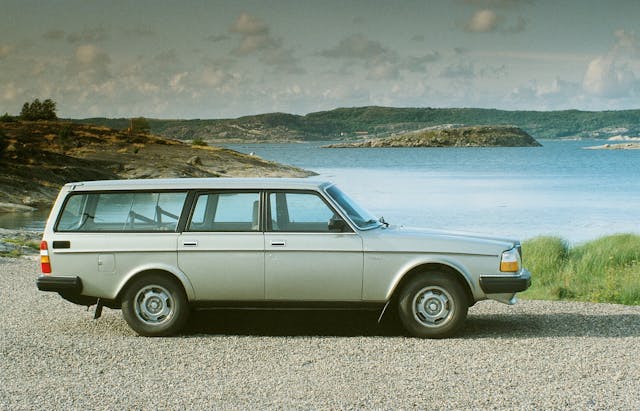
Trim levels simplified for the 1983 model year: DL, GL, Turbo. The DL and Turbo were available in all three body styles. The GL, in only the four-door sedan and wagon, and with either the gas or diesel engines, with no mechanical changes. Volvo also introduced the B23F, with slightly higher compression for a boost to 114 hp. For the 1983 model year, Volvo sold 12,893 242 two-door sedans, 125,639 244 four-door sedans, and 71,295 245 wagons.
1984
The major change for this Orwellian model year was the elimination of the two-door sedan. It had been relegated to entry-level status in the DL line, and after 1984, it was out of the picture entirely. Front and rear bumpers became more streamlined across the range. The big news for Volvo was—finally, after a decade—another car. The 740 debuted, and while you might think it spelled the end for Volvo’s oldest car, it sold more 240s in 1984 than at any point in its history. For the 1984 model year, Volvo sold 133,104 244 four-door sedans and 85,729 245 wagons.
1985–93
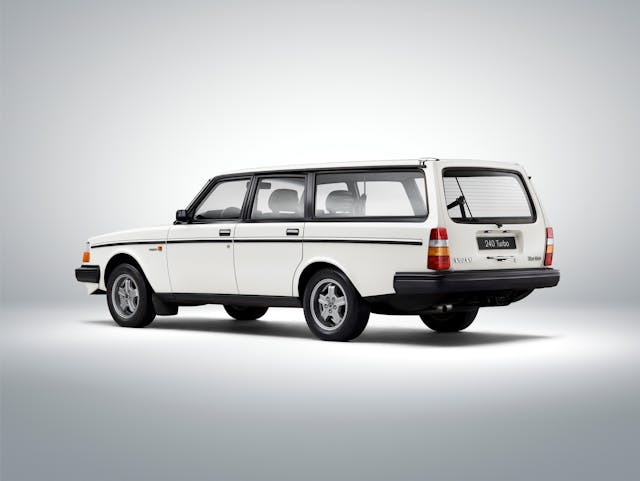
The B230F (and with it the turbocharged FT, but in cars other than the 240) arrived in 1985. With Bosch LH 2.2-Jetronic fuel injection and 9.8:1 compression, the B230F wasn’t more powerful than the B23F, but that changed when you put a turbo on it. Unfortunately, that wasn’t in the cards for the 240. But with that bit of good news, you could really start to see the end for the 240, although it would take years to happen. The Diesel? The Turbo? Both were kaput after 1985. What was left were the DL and GL, in both four-door and wagon form.
The M47, a true five-speed manual transmission, replaced the M46 in 1987. In 1988, the B230F underwent some revisions to resolve a piston slap issue. These engines have a “K” cast into the block, but only for 1988 and ’89 model years. They also have provisions for oil squirters, but the squirters themselves didn’t appear in these engines until 1993, leading to a lot of confusion among backyard Volvo power builders.
Between 1985 and ’93, Volvo built 342,584 244 four-door sedans and 242,666 245 wagons. A couple of interesting notes about those numbers: Volume really didn’t taper until 1990–91, partly because of a recession that hurt auto sales across the board. Second, in the last three years of production, wagon sales either tied or outpaced sedan sales, in the final year by a gap larger than 2:1.
Before you buy
Rust is going to be the big issue, especially if you want an older 240. Check the obvious areas (rocker panels, wheel arches, floors), but rust can be highly specific to different years of the 240. The 1974–76 cars will rust badly on the front fenders behind the turn-signal lamps, because inner splash shields weren’t installed to protect these areas until 1977.
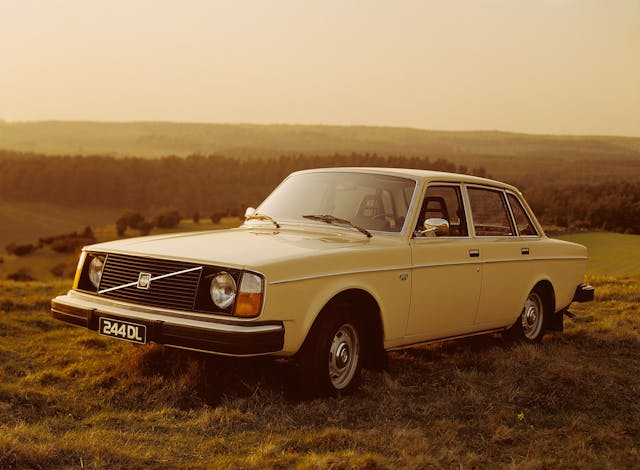
The hood, battery box, radiator core support, and firewall are all prone to rust. The three-part rocker panels are known rust offenders, as are the rear wheel arches. The pinch weld that forms the windshield and backlight openings are susceptible to rust, and the gasket and trim will hide it. The rear window opening on the wagons, in particular, can rust badly. In the cargo area of both sedans and wagons, check the covered recessed areas on either side (known affectionately as “butt cheeks”), which often hold water. Blocked drain holes in the doors can cause the door bottoms to rot. Things got better around 1987 and 88, when the entire body (except for the roof panel) was galvanized. They’ll still rust, especially if they’ve been in an accident, but galvanizing definitely helped to hold it off.
The only weak point on the early B20 engines is the timing gear, which was made of Novotext (essentially Bakelite with cotton fiber reinforcement.) The gears themselves were acceptable, but they separated from their steel hub, causing an obvious issue, although not catastrophic since these were non-interference engines. Replacement steel gears are available in the aftermarket.
Regarding the Redblock engines, look for all the normal internal combustion engine issues, but these are some of the most reliable engines ever built. At this point the only thing to consider is that they’re old and simply worn out. Unless you’re sold on buying one of the earliest cars, there’s hardly any reason not to buy one past the galvanization era, with the B230F engine that appeared in 1985. The Bosch LH 2.2-Jetronic fuel injection has the advantage of parts availability, which is dwindling for K-Jetronic and getting even more difficult for D-Jetronic in the earliest 240s.
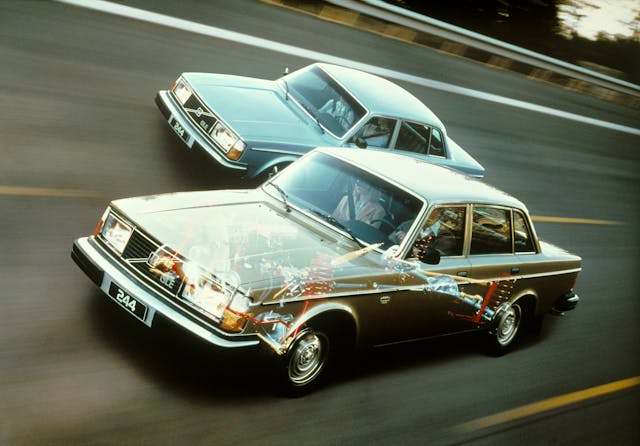
M40/M41 and M45/M46 manual gearboxes suffered failures with stock power. If you’re building a 240 with better than that, consider a Getrag or Tremec swap for its future. The BW35 and 55 and Aisin-Warner 70 are all fairly stout and won’t cost a fortune to rebuild. As with all automatic transmissions, introduction of antifreeze through the transmission cooler will kill them.
The Achilles heel in the 240s built between 1980 and ’87 was the engine wiring harness. They’re all bad. They will eventually fall apart from engine heat. The insulation simply crumbles off the wire, leaving all the electricity to run out on the floor. Look at one or both of the gray 8-pole connectors near the firewall or on wires going to or near the alternator, and it’ll tell you if the insulation has failed yet. Dave Barton at Prancing Moose sells replacements—and provides a lot of great information for free—for around $230.
Valuation
Our teammates with the Hagerty Valuation Team don’t include these cars in the Hagerty Price Guide yet, but they still have significant insight into current values. Quality examples get harder to find with each passing year, despite the fact that Volvo built them by the hundreds of thousands each model year.
At this writing, there’s exactly one Volvo 240 on BringATrailer.com, a very clean 1993 240 wagon, with A/C, heated seats, and a Pioneer audio system. It’s bid up to $10,250 with two days to go. Over the last year, the sweet spot seems to hover right at that price point. Between $9000 and $11,000 would net you an early 1980s DL in any body style, all in rust-free condition. The outliers include a 1983 242 Turbo, claimed to be one of 500 flat-hood cars built for Group-A homologation, at $20,000 at the top, and a clean 240 DL with 130,000 miles and a Southwest history that sold for just $5000 at the bottom.
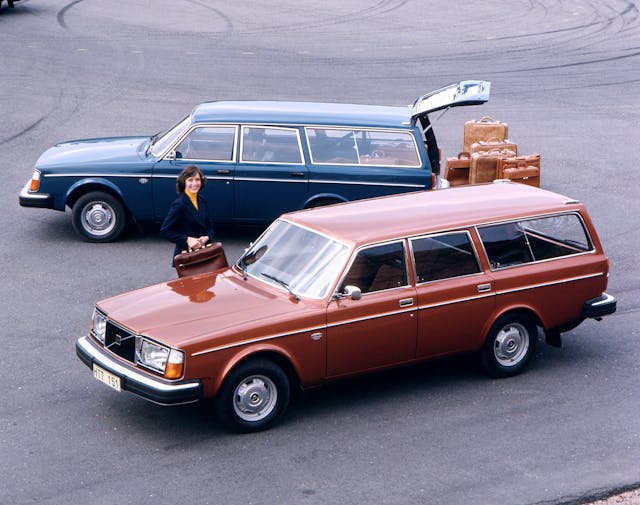
The Valuation Team notes that the average value quoted by Hagerty for all Volvo 240s is $5957. The appeal for these cars stretches across almost all generations, which isn’t surprising because Volvo started building 240s around the time of the first talkies. Boomers quoted 34 percent of the 240s last year, and Gen X wasn’t far behind at 29 percent. Millennials and Gen Z together quoted 31 percent of the 240s last year. Only Pre-boomers have a passing interest in Volvo 240s, requesting just six percent of the quotes last year.
Volvo 240s have always said something about their owners. It used to be “I’m a college professor in Vermont, like tweed, and smoke a pipe.” But over the years, these cars have become appealing to a wide range of enthusiasts who appreciate form dictated by function. “It might be because the car is a little square and sluggish, just like the Swedes themselves,” its designer, Jan Wilgaard, said. He’s not wrong.
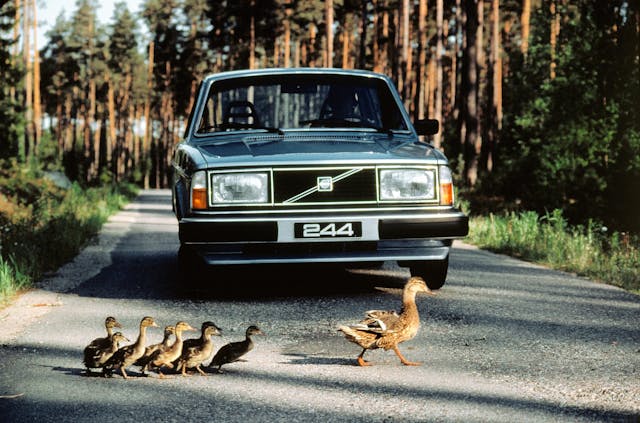



















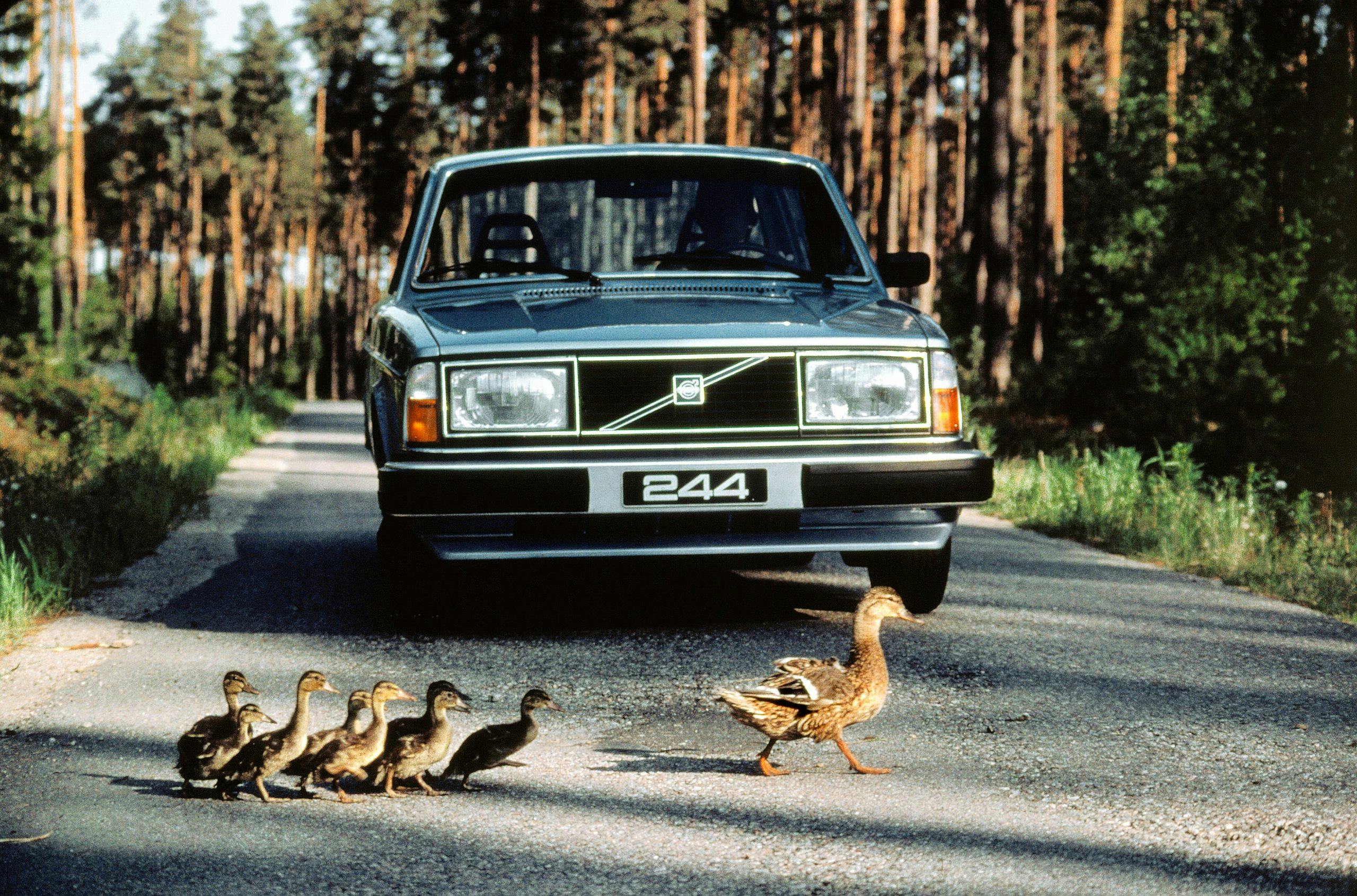
love the 85 245 picture, I have a 84.
I have a 1993 240 wagon with 84000 original miles on her no rust runs like a clock
Sadly here in Australia prices don’t seem achievable. I have an immaculate 89 240 wagon at the equivalent of 5K USD, about half what I think it’s worth, and the one person who’s inspected it thought the interior should be like brand new. Very very frustrating that classic car buyers have unrealistic expectations. Sure, I could spend say $500 and make the car perfect and then it should be worth 10K USD, but if nobody is looking at it for my existing asking price where to from here?
Love Volvos and Australia. Keep the Volvo!